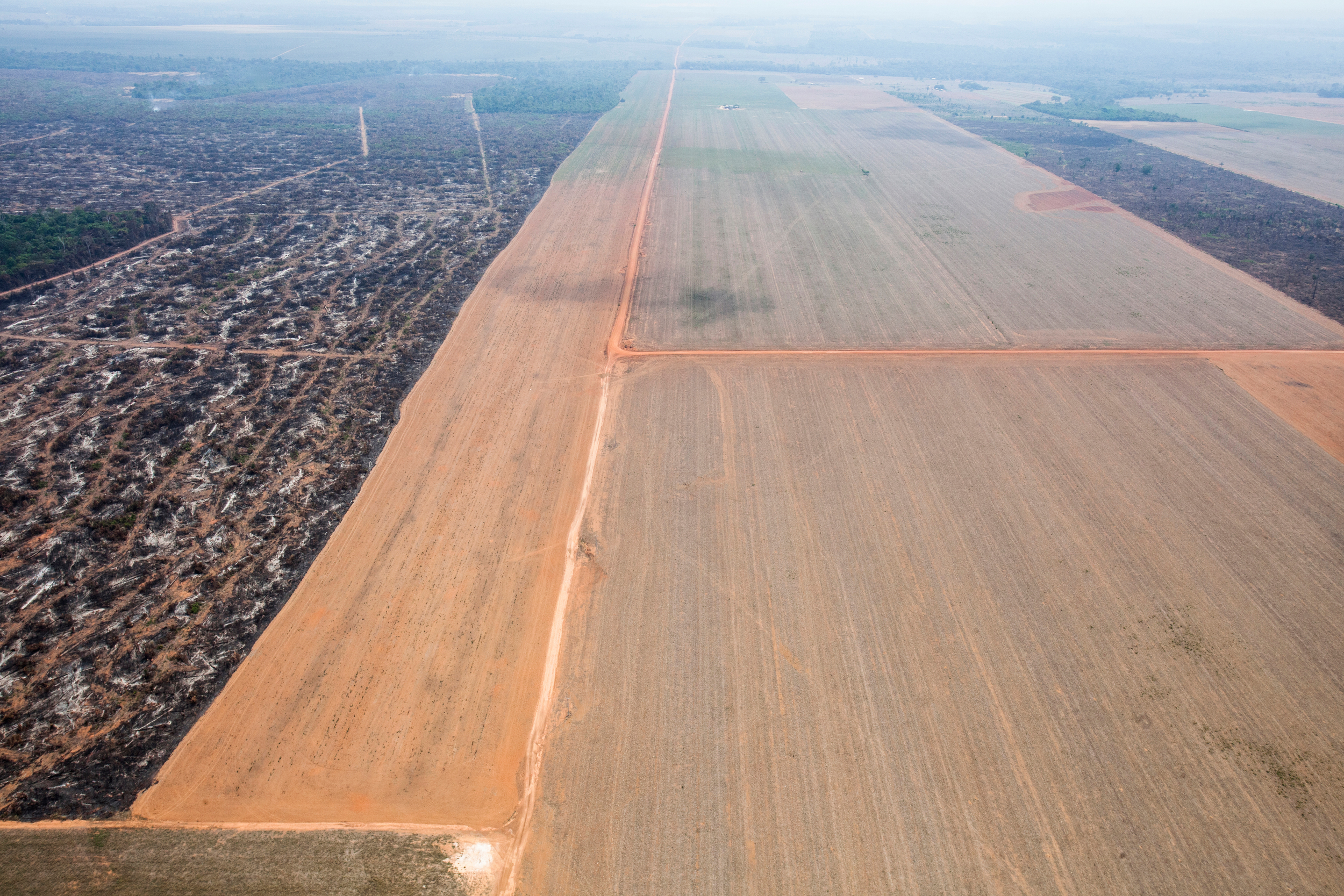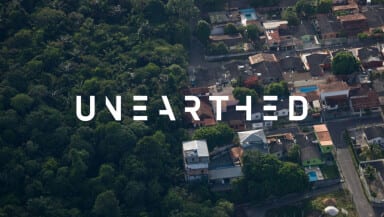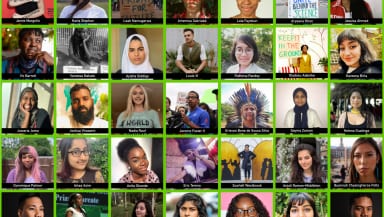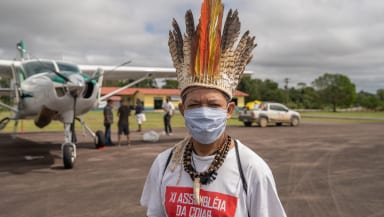As the rapid spread of coronavirus has shown, even small changes in nature can have a huge impact, particularly once we hit a tipping point.
The same is true for the destruction of the Amazon. The problem is that the changes happening there are far from small – they’re likely to alter the climate, irreparably, forever.
As coronavirus began to spread around the world, the clearing of Amazon rainforest land for meat production, logging and mining went into overdrive. In the first four months of the year, the Brazilian monitoring body registered a 55% increase in deforestation from the same period in 2019.
This devastation of nature poses an increasing threat to Brazil’s Indigenous Peoples – the guardians of the rainforest, and for whom its destruction is a matter of life and death.
Why is the Amazon being destroyed so quickly?
While the rest of us were going into coronavirus lockdowns, large areas of climate-stabilising rainforest were being cleared for cattle ranches, logging and mining operations. The Brazilian government pushes forward with its “development” of Amazon land by encouraging largely illegal forest clearing for meat production and timber and mineral extraction.
According to Greenpeace Unearthed, deforestation alerts in the Brazilian Amazon jumped by 64% in April compared to last year – and this is unusual during the rainy season, when tree clearing is more difficult.
Now, the world’s biggest rainforest is yet again entering its dry season, which means it will also face another spate of fires. Fires raged through the Amazon in 2019, shocking the world with the scale of the damage. Apocalyptically black skies in the middle of the day in São Paulo, thousands of miles from the blazes, were beamed around the world.
While some fires start naturally, a vast amount of last year’s Amazon fires were lit by farmers to clear land for agribusiness, a politically powerful sector in Brazil – which has the full support of president Jair Bolsonaro. Now, the land-clearing is getting much, much worse.
Bolsonaro is using the shock of coronavirus, which has made environmental oversight much harder in Brazil, to push the expansion of industrial farming in the Amazon.

- Area of Mato Grosso that has been deforested and burned for agricultural expansion. Flying over rainforested northern Mato Grosso, Greenpeace identifies farms with evidence of recent deforestation, caused by soy production and cattle raising.
Under the cover of worldwide coronavirus lockdowns, Bolsonaro has been trying to pass a bill in Brazil’s Congress to give land grabbers the rights to stolen forests. Thankfully, public pressure from major pension funds and more than 40 European companies – including Tesco and Marks & Spencer – helped get the vote postponed indefinitely, fending off this threat for now.
The fight is far from over though, and there is still a lot of UK money backing Brazilian agribusiness. In June 2020, Greenpeace’s investigative journalists found that British-based banks and finance houses have provided more than $2 billion in financial backing in recent years to Brazilian beef companies linked to Amazon deforestation.
Why are rainforests like the Amazon so important?
Trees absorb carbon dioxide from the air as they grow. So when rich, biodiverse tropical forests like the Amazon are destroyed, the planet loses increasingly valuable carbon storage capacity. The more carbon dioxide there is in the atmosphere, the more serious the climate emergency gets for the whole world.
And it doesn’t have to be huge tracts of forest being cleared or going up in flames. Even seemingly minor degradation can have a big impact on the forest’s ability to absorb carbon dioxide.
Scientists believe that a “tipping point” – the point beyond which the rainforest can no longer generate enough rain to sustain itself – could be reached in the Amazon in the next couple of decades. This is where some 20-25% forest loss, plus fires, turns much of the tropical rainforest into a kind of dry savannah, but with far less biodiversity. This would release billions of tonnes of carbon into the atmosphere.
In late 2019, economist Monica de Bolle told a US Congress committee that she believes that this point could be as close as 2021, particularly if deforestation continues to increase year-on-year – as has been happening so far.
How are the people in the Amazon coping with the coronavirus crisis?
Brazil as a whole is also one of the worst-affected countries in the world by the pandemic. Despite the country’s excellent public health service (the biggest in the world and modelled on the NHS), Bolsonaro has already been through two health ministers (one was sacked and one resigned), encouraged anti-lockdown protests, and was recently accused of hiding the true extent of daily death tolls.
Experts are now worried that an overlap of the fires starting again and Covid-19 cases peaking too would be a “catastrophe” for the Brazilian Amazon.
The immediate risks to the region’s nearly one million-strong Indigenous Peoples in Brazil are particularly severe – especially under a government with little to no concern for Indigenous Peoples’ human rights.
In a tragic echo of both the colonial and dictatorship eras in Brazil’s history, the encroachment of illegal ranchers, loggers and gold miners – emboldened by a reduction in inspectors due to the pandemic – threatens to bring coronavirus and wipe out entire villages.
The coronavirus has taken so many Indigenous elders, Indigenous Peoples in Brazil are losing not just loved ones but the keepers of their unique cultural histories.
Greenpeace has been part of an emergency effort working with a number of Indigenous and civil society groups, together with healthcare professionals, to help provide and transport emergency aid to remote areas.
As industrial farming pushes further into wild areas where only Indigenous Peoples might have gone before, there’s also a growing risk from new diseases, which can jump to humans from once-isolated animal populations.
How is deforestation linked to new diseases?
Experts are building an understanding of how diseases like coronavirus emerge. There is increasing evidence that industrial animal agriculture encroaching on wild habitats is a firm culprit.
Another of Greenpeace Unearthed’s recent investigations in Brazil found that scientists in the Amazon saw the coronavirus crisis coming. Many new diseases have emerged in Brazil and in other parts of the world as a result of destroying forests and other natural environments – including chikungunya, dengue fever, yellow fever, Zika, hantavirus, leptospirosis and leishmaniasis.
The prognosis for the Amazon isn’t great, but there are some glimmers of hope. The pressure that forced Bolsonaro’s land-grabbing bill out of Congress came partly from major food brands in Europe. They know their customers don’t want chicken, meat or the soya used to feed farm animals worldwide to be linked to human rights violations, or the devastation of forests that keep our planet cool.
Bolsonaro thinks the Amazon is nobody’s business but Brazil’s. Food brands and their customers around the world have the power to show him otherwise.
Some of the UK’s biggest supermarkets and fast food chains are complicit: Tesco, Sainsbury’s, Asda, Burger King, McDonald’s and KFC are all churning out industrial meat that’s fuelling deforestation.
And Tesco uses more soya for animal feed than any supermarket in the UK. They have the power to help break this destructive cycle. But so far they’ve taken no meaningful action.




